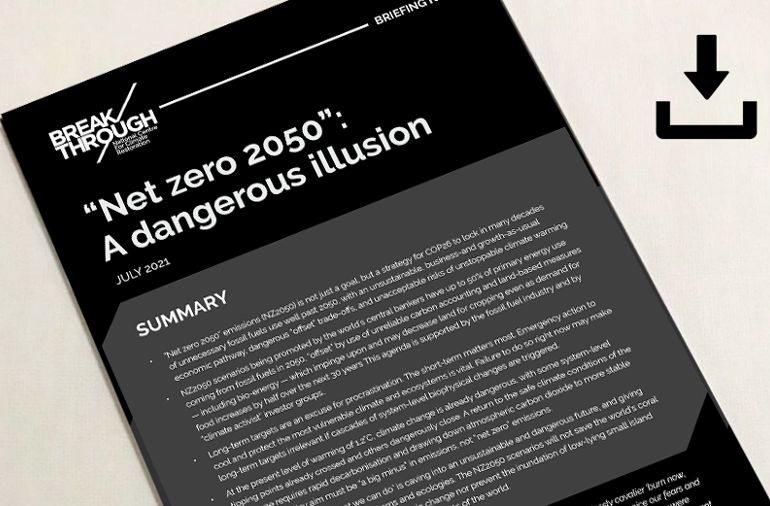“Net zero 2050” is the big story in climate politics this year, leading up to the global policymaking festival, the 26th Conference of the Parties, in Glasgow this year from 1–12 November. The question is whether it is a good story.
That’s the subject of a new Briefing Note, just released by the Breakthrough National Centre for Climate Restoration, and available here.
Net zero pledges are everywhere. The goal of “Net zero 2050” (NZ2050) greenhouse gas emissions is centre stage leading up to Glasgow. A majority of nations support the goal, as do many global corporations including fossil fuel producers such as Shell, BP and Exxon, investors and, in Australia, the major business lobby groups.
But NZ2050 is not just a goal, it also represents a strategy: it is a contested space about the energy mix, the pace of change and economic and social pathways to 2050. A number of high profile NZ2050 scenarios have been produced, including by the Intergovernmental Panel on Climate Change, the International Energy Agency and the central bankers’ and financial regulators Network for Greening the Financial System. Some of their scenarios have up to 50% of primary energy coming from fossil fuels by 2050! Others rely on technologies not yet deployed at scale, such as BECCS, for 20% of energy by 2050. The scenarios are a veritable show bag of technocratic dreaming, gas expansion and assumptions about economic growth unconcerned by material resource limits.
NZ2050 also lacks short-term ambition. Despite the growing enthusiasm for this seemingly positive development, a global stocktake of net zero plans finds 80% fail to meet a minimum set of robustness criteria and lack substance and short-term ambition, leading to greenwashing and marketing deception, says Ketan Joshi, writing for Renew Economy, and a catastrophic failure to form action that will provide meaningful protection.
When advocates support NZ2050 they are tacitly supporting a dangerous agenda leading up to COP 26 in Glasgow that will codify an unsustainable pathway with continuing high fossil fuel use, dangerous “offset” trade-offs, and unacceptable risks of unstoppable climate warming.
Long-term targets are an excuse for procrastination. The short-term matters most: “What we do in the next 3-4 years, I believe, will determine the future of humanity,” says former UK Chief Scientist Sir David King. He says emergency action to cool and protect the most vulnerable climate and ecosystems is vital. Failure to do so right now may make long-term targets irrelevant if cascades of system-level changes are triggered, for example in the Arctic.
So what did our Briefing Note find? Here is the summary:
- “Net zero 2050” emissions (NZ2050) is not just a goal, but a strategy for COP26 to lock in many decades of unnecessary fossil fuels use well past 2050, with an unsustainable, business-and growth-as-usual economic pathway, dangerous “offset” trade-offs, and unacceptable risks of unstoppable climate warming.
- NZ2050 scenarios being promoted by the world’s central bankers have up to 50% of primary energy use coming from fossil fuels in 2050, “offset” by use of unreliable carbon accounting and land-based measures — including bio-energy — which impinge upon and may decrease land for cropping even as demand for food increases by half over the next 30 years This agenda is supported by the fossil fuel industry and by “climate activist” investor groups.
- Long-term targets are an excuse for procrastination. The short-term matters most. Emergency action to cool and protect the most vulnerable climate and ecosystems is vital. Failure to do so right now may make long-term targets irrelevant if cascades of system-level biophysical changes are triggered.
- At the present level of warming of 1.2°C, climate change is already dangerous, with some system-level tipping points already crossed and others dangerously close. A return to the safe climate conditions of the Holocene requires rapid decarbonisation and drawing down atmospheric carbon dioxide to more stable levels. The policy aim must be “a big minus” in emissions, not “net zero” emissions.
- Saying NZ2050 is “the best we can do” is caving into an unsustainable and dangerous future, and giving up on protecting major Earth systems and ecologies. The NZ2050 scenarios will not save the world’s coral reefs, nor stop rapid and devastating Arctic change nor prevent the inundation of low-lying small island states, or the triggering of societal collapse in parts of the world.
In researching NZ2050, I was indebted to the climatologists who have shone a light into this dark corner. Most notable was a very widely-read article in The Conversation by James Dyke, Robert Watson and Wolfgang Knorr on 21 April this year:
“We have arrived at the painful realisation that the idea of net zero has licensed a recklessly cavalier ‘burn now, pay later’ approach which has seen carbon emissions continue to soar… The time has come to voice our fears and be honest with wider society. Current net zero policies will not keep warming to within 1.5°C because they were never intended to. They were and still are driven by a need to protect business as usual, not the climate. If we want to keep people safe then large and sustained cuts to carbon emissions need to happen now.”
It was titled: “Climate scientists: concept of net zero is a dangerous trap”. Too true.
DOWNLOAD Briefing Paper: “Net zero 2050” is a dangerous illusion.





